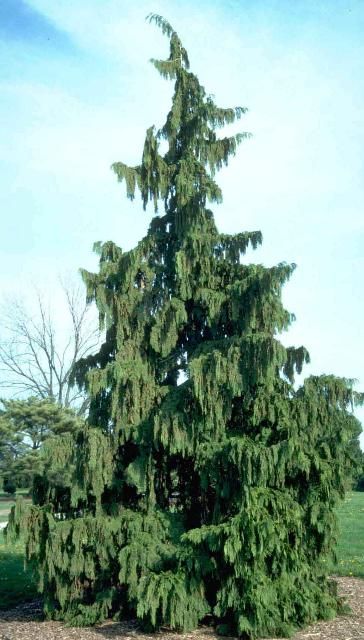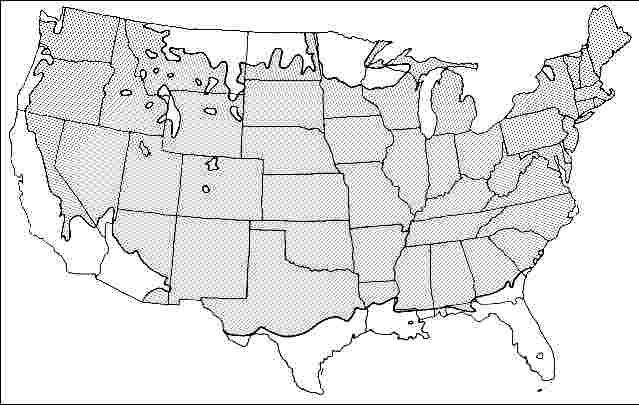Introduction
A graceful, weeping, pyramidal evergreen, nootka falsecypress can reach 60 to 90 feet in the wild but stays within a height of 35 feet and a spread of 20 feet in cultivation. The trunk remains straight and dominant throughout the life of the tree. The long, pendulous, flattened branches are clothed with dark bluish-green or grayish-green, scalelike "needles," which give off a rank odor when bruised or crushed. Nootka falsecypress is native to coastal Alaska and Washington, performing best in areas with high humidity and moist soil conditions.

Credit: Ed Gilman, UF/IFAS
General Information
Scientific name: Chamaecyparis nootkatensis
Pronunciation: kam-eh-SIP-uh-riss noot-kuh-TEN-sis
Common name(s): Nootka falsecypress, Alaska cedar
Family: Cupressaceae
USDA hardiness zones: 4A through 8A (Fig. 2)
Origin: native to North America
Invasive potential: little invasive potential
Uses: specimen; deck or patio; highway median; bonsai; container or planter
Availability: somewhat available, may have to go out of the region to find the tree

Description
Height: 35 to 50 feet
Spread: 15 to 20 feet
Crown uniformity: irregular
Crown shape: weeping, pyramidal
Crown density: moderate
Growth rate: moderate
Texture: fine
Foliage
Leaf arrangement: opposite/subopposite
Leaf type: simple
Leaf margin: entire
Leaf shape: scale-like
Leaf venation: none, or difficult to see
Leaf type and persistence: evergreen, fragrant
Leaf blade length: less than 2 inches
Leaf color: blue or blue-green, green
Fall color: no color change
Fall characteristic: not showy
Flower
Flower color: unknown
Flower characteristics: not showy
Fruit
Fruit shape: round, cone
Fruit length: less than .5 inch
Fruit covering: dry or hard
Fruit color: brown
Fruit characteristics: does not attract wildlife; not showy; fruit/leaves not a litter problem
Trunk and Branches
Trunk/bark/branches: branches droop; not showy; typically one trunk; thorns
Pruning requirement: little required
Breakage: resistant
Current year twig color: green, brown
Current year twig thickness: thin
Wood specific gravity: 0.44
Culture
Light requirement: partial sun or partial shade, shade tolerant, full sun
Soil tolerances: clay; sand; loam; acidic; well-drained
Drought tolerance: moderate
Aerosol salt tolerance: unknown
Other
Roots: not a problem
Winter interest: no
Outstanding tree: yes
Ozone sensitivity: unknown
Verticillium wilt susceptibility: resistant
Pest resistance: resistant to pests/diseases
Use and Management
It makes a striking specimen, with a distinct, graceful, weeping habit. Even one plant will soften any landscape. Use it near water or around a patio or as a lawn specimen in residential or commercial landscapes. It reportedly does best with some shade from the afternoon sun, particularly in the southern part of its range. Trees in full sun look great in zone 5.
Pests
Juniper scale can be controlled by applying pesticides when the crawlers are active.
The bagworm webs foliage and debris together to make a case. The covering makes the insect difficult to control. The nests can be picked off by hand.
Diseases
Blight can be a problem on young plants in nurseries or old plants in landscape situations. In young plants, branch tips turn brown and die back until the whole branch or young tree is killed. Tip blight infects trees during wet weather. The disease causes sooty pustules on the leaves, bark, and cones.
Trees over five years old are less susceptible. When older trees in landscapes are affected by tip blight, entire trees are seldom killed.
Scorch may look like a disease but is caused by excessive direct sun, freezing stress, drought, or mites. Freezing stress can be prevented by shading small plants in winter.